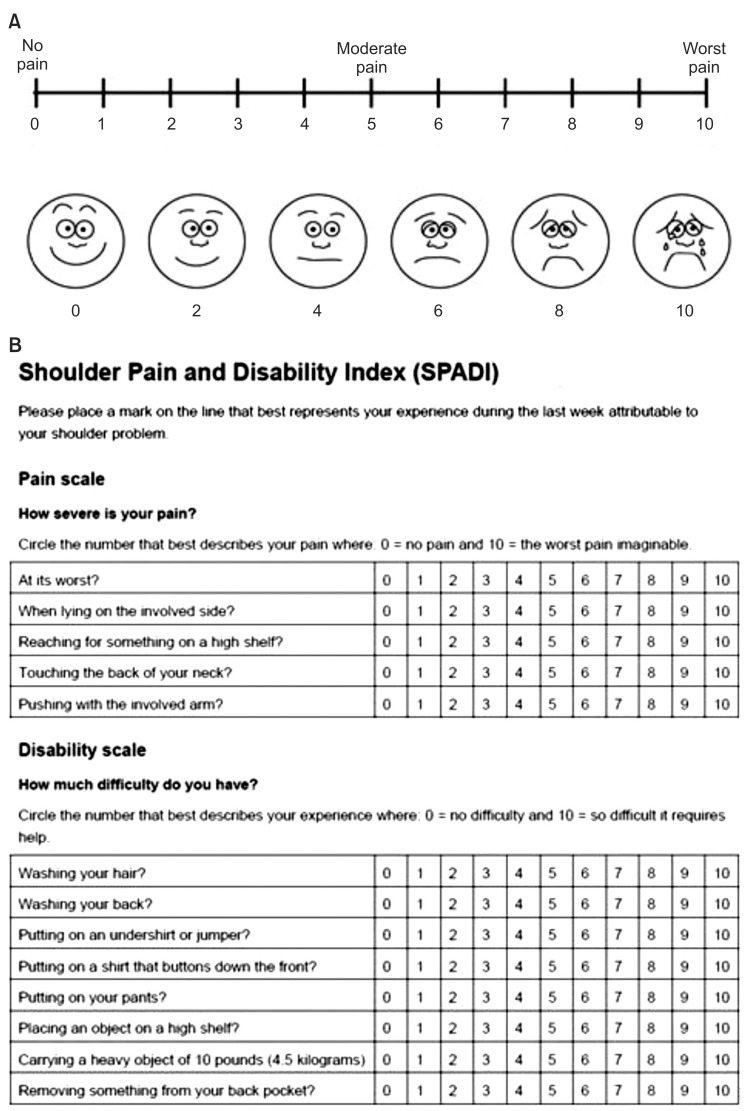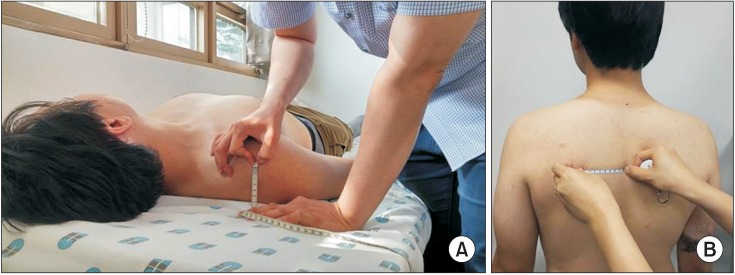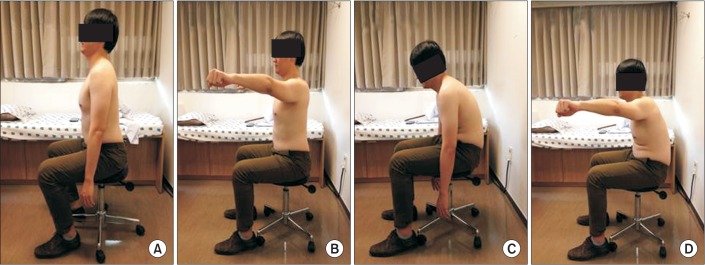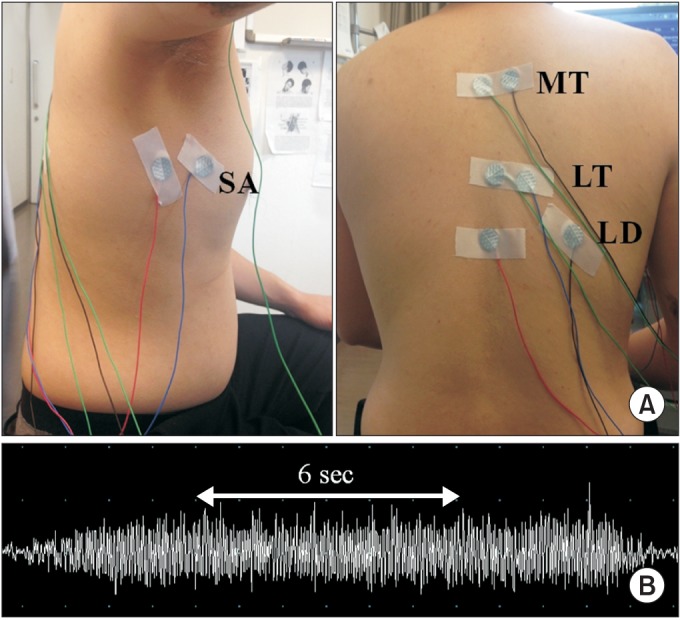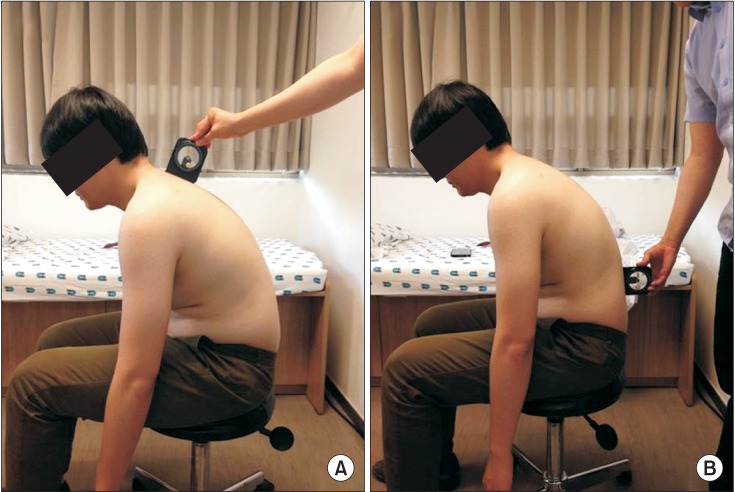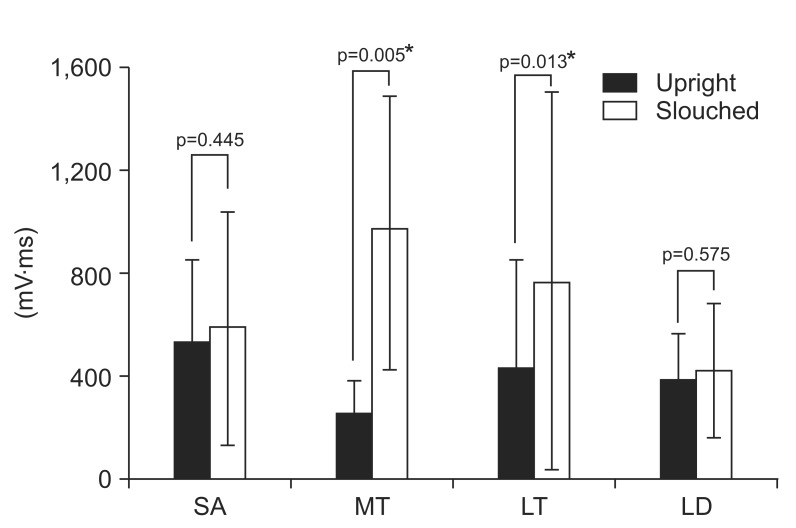Ann Rehabil Med.
2016 Apr;40(2):318-325. 10.5535/arm.2016.40.2.318.
Changes in Activation of Serratus Anterior, Trapezius and Latissimus Dorsi With Slouched Posture
- Affiliations
-
- 1Department of Rehabilitation Medicine, CHA Bundang Medical Center, CHA University, Seongnam, Korea. minkh@chamc.co.kr
- KMID: 2309932
- DOI: http://doi.org/10.5535/arm.2016.40.2.318
Abstract
OBJECTIVE
To compare quantitative muscle activation between erect and slouched sitting postures in the muscles around the scapula, and to investigate the correlation between the angle of thoracic kyphosis and the alteration of muscle activity depending on two different sitting postures.
METHODS
Ten healthy males participated in the study. Unilateral surface electromyography (SEMG) was performed for serratus anterior, middle trapezius (MT), and lower trapezius (LT), which are scapular stabilizer muscles, as well as latissimus dorsi. Participants elevated their shoulders for 3 seconds up to 90° abduction in the scapular plane, tilting 30° anterior in the coronal plane. They were told to hold the position for 10 seconds and voluntary isometric contractions were recorded by SEMG. These movement procedures were conducted for three times each for erect and slouched sitting postures and data were averaged.
RESULTS
Activities of MT and LT increased significantly more in the slouched sitting posture than in the erect one. There was no significant correlation between kyphotic angle and the area under curve of each muscle.
CONCLUSION
Because MT and LT are known as prime movers of scapular rotation, the findings of this study support the notion that slouched sitting posture affects scapular movement. Such scapular dyskinesis during arm elevation leads to scapular stabilizers becoming overactive, and is relevant to muscle fatigue. Thus, slouched sitting posture could be one of the risk factors involved in musculoskeletal pain around scapulae.
Keyword
MeSH Terms
Figure
Reference
-
1. Dolan KJ, Green A. Lumbar spine reposition sense: the effect of a 'slouched' posture. Man Ther. 2006; 11:202–207. PMID: 16621667.
Article2. Kleine BU, Schumann NP, Bradl I, Grieshaber R, Scholle HC. Surface EMG of shoulder and back muscles and posture analysis in secretaries typing at visual display units. Int Arch Occup Environ Health. 1999; 72:387–394. PMID: 10473838.
Article3. Mirbagheri SS, Rahmani-Rasa A, Farmani F, Amini P, Nikoo MR. Evaluating kyphosis and lordosis in students by using a flexible ruler and their relationship with severity and frequency of thoracic and lumbar pain. Asian Spine J. 2015; 9:416–422. PMID: 26097657.
Article4. Snijders CJ, Hermans PF, Niesing R, Jan Kleinrensink G, Pool-Goudzwaard A. Effects of slouching and muscle contraction on the strain of the iliolumbar ligament. Man Ther. 2008; 13:325–333. PMID: 17553728.
Article5. Caneiro JP, O'Sullivan P, Burnett A, Barach A, O'Neil D, Tveit O, et al. The influence of different sitting postures on head/neck posture and muscle activity. Man Ther. 2010; 15:54–60. PMID: 19643658.
Article6. Finley MA, Lee RY. Effect of sitting posture on 3-dimensional scapular kinematics measured by skinmounted electromagnetic tracking sensors. Arch Phys Med Rehabil. 2003; 84:563–568. PMID: 12690596.
Article7. Imagama S, Hasegawa Y, Wakao N, Hirano K, Muramoto A, Ishiguro N. Impact of spinal alignment and back muscle strength on shoulder range of motion in middle-aged and elderly people in a prospective cohort study. Eur Spine J. 2014; 23:1414–1419. PMID: 24578093.
Article8. Nijs J, Roussel N, Vermeulen K, Souvereyns G. Scapular positioning in patients with shoulder pain: a study examining the reliability and clinical importance of 3 clinical tests. Arch Phys Med Rehabil. 2005; 86:1349–1355. PMID: 16003663.
Article9. Brumitt J. Scapular-stabilization exercises: early-intervention prescription. Athl Ther Today. 2006; 11:15–18.
Article10. Voight ML, Thomson BC. The role of the scapula in the rehabilitation of shoulder injuries. J Athl Train. 2000; 35:364–372. PMID: 16558649.11. Ludewig PM, Reynolds JF. The association of scapular kinematics and glenohumeral joint pathologies. J Orthop Sports Phys Ther. 2009; 39:90–104. PMID: 19194022.
Article12. Escamilla RF, Yamashiro K, Paulos L, Andrews JR. Shoulder muscle activity and function in common shoulder rehabilitation exercises. Sports Med. 2009; 39:663–685. PMID: 19769415.
Article13. Bullock MP, Foster NE, Wright CC. Shoulder impingement: the effect of sitting posture on shoulder pain and range of motion. Man Ther. 2005; 10:28–37. PMID: 15681266.
Article14. Kanlayanaphotporn R. Changes in sitting posture affect shoulder range of motion. J Bodyw Mov Ther. 2014; 18:239–243. PMID: 24725793.
Article15. Lewis JS, Valentine RE. Clinical measurement of the thoracic kyphosis. A study of the intra-rater reliability in subjects with and without shoulder pain. BMC Musculoskelet Disord. 2010; 11:39. PMID: 20193055.
Article16. Lee HS, Shim JS, Lee ST, Kim M, Ryu JS. Facilitating effects of fast and slope walking on paraspinal muscles. Ann Rehabil Med. 2014; 38:514–522. PMID: 25229030.
Article17. Cools AM, Witvrouw EE, De Clercq GA, Danneels LA, Willems TM, Cambier DC, et al. Scapular muscle recruitment pattern: electromyographic response of the trapezius muscle to sudden shoulder movement before and after a fatiguing exercise. J Orthop Sports Phys Ther. 2002; 32:221–229. PMID: 12014826.
Article18. Holtermann A, Roeleveld K, Mork PJ, Gronlund C, Karlsson JS, Andersen LL, et al. Selective activation of neuromuscular compartments within the human trapezius muscle. J Electromyogr Kinesiol. 2009; 19:896–902. PMID: 18585928.
Article19. Park SY, Yoo WG. Differential activation of parts of the latissimus dorsi with various isometric shoulder exercises. J Electromyogr Kinesiol. 2014; 24:253–257. PMID: 24462394.
Article20. Beaudette SM, Unni R, Brown SH. Electromyographic assessment of isometric and dynamic activation characteristics of the latissimus dorsi muscle. J Electromyogr Kinesiol. 2014; 24:430–436. PMID: 24735642.
Article21. Noguchi M, Chopp JN, Borgs SP, Dickerson CR. Scapular orientation following repetitive prone rowing: implications for potential subacromial impingement mechanisms. J Electromyogr Kinesiol. 2013; 23:1356–1361. PMID: 24055533.
Article22. Ludewig PM, Cook TM. Alterations in shoulder kinematics and associated muscle activity in people with symptoms of shoulder impingement. Phys Ther. 2000; 80:276–291. PMID: 10696154.
Article23. McLean L. The effect of postural correction on muscle activation amplitudes recorded from the cervicobrachial region. J Electromyogr Kinesiol. 2005; 15:527–535. PMID: 16150608.
Article24. Poppen NK, Walker PS. Normal and abnormal motion of the shoulder. J Bone Joint Surg Am. 1976; 58:195–201. PMID: 1254624.
Article25. Bagg SD, Forrest WJ. A biomechanical analysis of scapular rotation during arm abduction in the scapular plane. Am J Phys Med Rehabil. 1988; 67:238–245. PMID: 3196449.
- Full Text Links
- Actions
-
Cited
- CITED
-
- Close
- Share
- Similar articles
-
- Combined Deficiency of Unilateral Partial Pectoralis Major and Serratus Anterior and Bilateral Whole Trapezius, and Latissimus Dorsi Muscle
- Anomalous Arterial Supply to the Serratus Anterior Muscle
- Comparisons of Shoulder Muscle Activity and Muscle Activity Ratio during Serratus Anterior Exercise between CrossFit Practitioners with/without Shoulder Impingement Syndrome
- Usefullness of Chimeric Flaps Based on the Subscapular Vascular System
- Effect of Shoulder Position on Scapular Muscle Activity during Scapular Protraction

